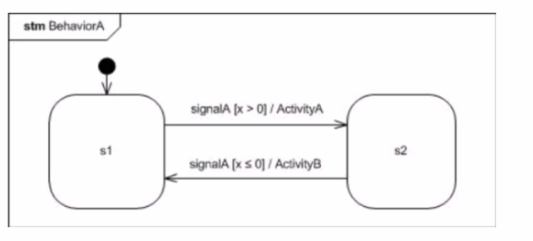OMG Exam OMG-OCUP2-FOUND100 Topic 4 Question 1 Discussion
Topic #: 4
Choose the correct answer:
The BchaviorA state machine shown below is at rest in state s1 and the value of x Is 0.

If a signalA event occurs, what is the state machine's subsequent behavior?
The image showcases a state machine named 'BehaviorA'. It consists of two states: s1 and s2. There's also a transition labeled 'signalA' connecting these states. However, a guard condition, '[x > 0]' is placed on the transition. This indicates that the signalA event will only trigger the transition if the expression x > 0 evaluates to true.
In the scenario you described, the state machine is currently in state s1, and the value of x is 0. Since the guard condition '[x > 0]' is not satisfied (because x is 0), the signalA event will not trigger a transition to state s2.
Here's a breakdown of why other options are incorrect:
Option A (The state machine will transition to state s2 and execute ActivityA during the transition) is not valid because the guard condition prevents the transition.
Option B (The state machine will execute ActivityA and remain in state s1) is incorrect as ActivityA is only associated with the transition, which isn't happening in this case.
Option D (The state machine will remain in state s1, and processing of the signalA event occurrence will be deferred until either the value of x changes or the state machine changes state) is not entirely accurate. While the state machine remains in s1, the processing of the signalA event is consumed immediately, not deferred.
Therefore, considering the state machine's visual representation and the guard condition, option C best describes the state machine's behavior. The signalA event is acknowledged but has no effect because the transition requirements aren't met.
Domingo
10 months agoPamella
10 months agoFiliberto
11 months agoDomingo
11 months agoLing
11 months agoMichell
11 months agoLing
11 months ago